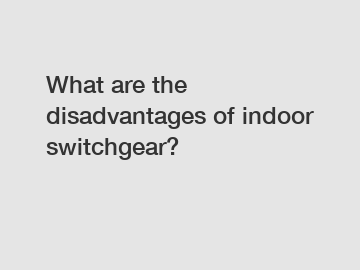What are the disadvantages of indoor switchgear?
In the world of electrical utilities, switchgear plays a crucial role in ensuring the safety and reliability of power distribution networks. Traditionally, outdoor switchgear has been the preferred choice for utilities due to its favorable characteristics. However, the advent of indoor switchgear has provided an alternate solution that offers certain advantages. In this blog, we will delve into the disadvantages of indoor switchgear, shedding light on whether it truly outweighs the benefits it provides.
1. Limited Space:
One of the significant drawbacks of indoor switchgear installations is the inherent limitation in space. Compared to outdoor switchgear, indoor counterparts require a dedicated indoor location, often leading to congestion in limited areas. This restriction can pose challenges in terms of accessibility, maintenance, and even future expansion plans.

2. Fire Safety Risks:
Safety concerns are a crucial factor when it comes to switchgear installations. One major disadvantage of indoor switchgear is the increased risk of fire hazards. Due to the presence of flammable materials and the enclosed environment, any electrical faults, such as arc flash incidents, have a higher likelihood of causing significant damage if not promptly detected and contained.
3. Higher Initial Costs:
Although indoor switchgear provides certain convenience benefits, it often comes with higher initial costs compared to its outdoor counterpart. The need for specialized indoor enclosures, fire protection measures, ventilation systems, and additional safety devices increase the overall installation and equipment costs. Such expenses can potentially limit the feasibility of indoor switchgear for smaller utilities or projects on a tight budget.
4. Ventilation and Cooling Requirements:
The enclosed environment of indoor switchgear necessitates robust ventilation and cooling systems. This requirement is essential to dissipate heat generated during normal operations and fault conditions. Implementing effective ventilation can be complex and may demand additional infrastructure investments, making indoor switchgear costlier to operate and maintain in the long run.
5. Increased Maintenance:
Maintenance of switchgear is key in ensuring optimal performance and the minimization of downtime. However, indoor switchgear arrangements often present challenges in terms of accessibility, leading to increased maintenance time and effort. The enclosed nature of indoor installations can also exacerbate issues, such as insulation degradation, dust accumulation, and insulation leakage, requiring regular inspections and preventive maintenance measures.
6. Limited Scalability:
The limited space within indoor switchgear installations can hinder scalability and future expansion plans. As power demands evolve or new equipment needs to be incorporated, additional equipment may have to be located in separate areas or even in new buildings. Such limitations can lead to increased complexity and operational challenges, potentially impacting the overall efficiency of the electrical system.
7. Environmental Concerns:
While indoor switchgear can be seen as a more aesthetically pleasing option, it also raises environmental concerns. The use of potent greenhouse gases, such as sulfur hexafluoride (SF6), in certain types of indoor switchgear can contribute to global warming. Strict regulations and environmental policies relating to SF6 emissions require added measures for containment, recycling, or replacement, further driving up the costs associated with indoor switchgear.
Conclusion:
Indoor switchgear offers certain advantages in terms of reduced footprint, security, and ease of access. However, it is crucial to weigh these benefits against the various disadvantages that come with indoor installations. Limited space, fire safety risks, higher initial costs, ventilation requirements, increased maintenance, limited scalability, and environmental concerns are all factors that utilities and stakeholders must consider before opting for indoor switchgear. By assessing these drawbacks alongside the context of specific requirements, utilities can make well-informed decisions while ensuring the safety, reliability, and sustainability of power distribution networks.
Contact us to discuss your requirements of power controlled ggd fixed switch cabinet, voltage xl, ring main unit. Our experienced sales team can help you identify the options that best suit your needs.


